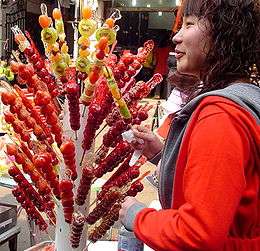Tanghulu
Tanghulu (simplified Chinese: 糖葫芦; traditional Chinese: 糖葫蘆; pinyin: tánghúlu) also called bingtanghulu, is a traditional Northern Chinese snack of candied Crataegus pinnatifida, also known as mountain hawthorn, Chinese haw, Chinese hawthorn, Chinese hawberry, or shanzha (山楂) in Mandarin Chinese. It consists of fruits covered in hard candy on bamboo skewers which are approximately 20 cm long. People often mistake tanghulu for regular candied fruits; however, they are coated in a hardened sugar syrup. This sweet and sour treat has been made since the Song Dynasty and remains popular throughout northern China.[1]
 Traditional bingtanghulu | |
| Alternative names | Bingtanghulu |
|---|---|
| Type | Confections |
| Place of origin | China |
| Region or state | Cities in China |
| Main ingredients | Crataegus pinnatifida, sugar syrup |
| Tanghulu | |||||||||||||||
|---|---|---|---|---|---|---|---|---|---|---|---|---|---|---|---|
| Traditional Chinese | 糖葫蘆 | ||||||||||||||
| Simplified Chinese | 糖葫芦 | ||||||||||||||
| Literal meaning | sugar bottle gourd | ||||||||||||||
| |||||||||||||||
| bīngtánghúlu | |||||||||||||||
| Traditional Chinese | 冰糖葫蘆 | ||||||||||||||
| Simplified Chinese | 冰糖葫芦 | ||||||||||||||
| Literal meaning | rock sugar bottle gourd | ||||||||||||||
| |||||||||||||||
The two common names for the confection literally mean "sugar bottle gourd" and "rock sugar bottle gourd," respectively. The "sugar" or "rock sugar" refers to the sugar coating, while the "bottle gourd" refers to the slight resemblance of the snack to the shape of a gourd.
Chinese hawthorn is the traditional fruit used for the skewering,[2] but in recent times vendors have also used various other fruits, such as cherry tomatoes, mandarin oranges, strawberries, blueberries, pineapples, kiwifruit, bananas, or grapes. The pits and seeds of the hawthorn are emptied out and are commonly filled with sweet red bean paste before being skewered and dipped.
Gallery
- Strawberry dipped with sugar coating for sale as a bintanghulu.
See also

- Crataegus pinnatifida
- Candy apple
- Rock candy
- Ligao Tang
- List of Chinese desserts
References
- Timothy G. Roufs Ph.D.; Kathleen Smyth Roufs (29 July 2014). Sweet Treats around the World: An Encyclopedia of Food and Culture: An Encyclopedia of Food and Culture. ABC-CLIO. p. 85. ISBN 978-1-61069-221-2.
- Mary Choate and Aaron Brachfeld (31 August 2015). At Home in Nature, a user's guide. Coastalfields Press. p. 315. GGKEY:K5213DDZJD2.